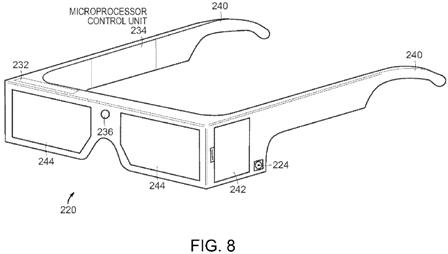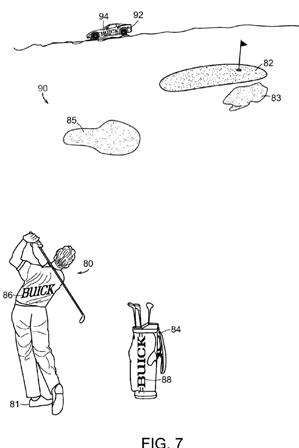Are Golfers Ready for Virtual Reality on the Golf Course?
Just like having to sit by the wall-mounted phone and wait for a call, the days of having to actually look at your GPS unit, or shoot the pin with your laser rangefinder, may be coming to an end. This week an interesting patent application published directed to the use of virtual reality on the golf course.
The application goes on to explain:
SUMMARY OF THE INVENTION
[0007] Generally speaking, the device and methods of the present invention enhance a golfer’s play and experience by using artificial reality (AR) messages in a perspective view from some golfer’s position. The AR messages for example, tell the golfer distance to a feature such as the pin on the green or a hazard the golfer should avoid. The perspective view is from the golfer’s position to the feature, with the AR message overlaid a background, giving the golfer better situation awareness for the golfer’s shot and club selection.
[0008] In one form, a handheld device for assisting a golfer during the play of a golf hole is provided, and includes a display screen, a GPS receiver for determining the position of the device on said golf hole and a memory storing the location of one or more features of said golf hole. The device also includes a processor operable for comparing said position with the location of a feature to determine a distance and a display operable to show the golfer’s perspective view of a background from said position to said feature. Thus, the golfer can view the display of said perspective view of the background with an augmented reality message depicting said distance imposed on the background. In one form, the feature is a location on a green of the golf hole being played and the background is a digital image. In a preferred form, the image is a photo digital image and said device includes a camera for capturing said photo digital image.[0009] In one embodiment, a method for viewing messages at a golf event in real time comprises determining the position of the golfer on a golf course using a GPS receiver and comparing the positions of one or more features on said golf course with said golfer position. An artificial reality (“AR”) message concerning said one or more features at said golf course is rendered in real time allowing viewing of the AR message with the viewpoint from said golfer position. The golfer can selectively change the viewpoint from said golfer position to another position. In a preferred form, the AR message is overlaid a photo image of a background environment, for example from the golfer’s position to the green. In one form, the AR message is transmitted to spectators.
[0010] In another embodiment, the method hereof contemplates playing a golf hole using a handheld device accompanying a golfer. In this embodiment, a position of said device on said golf hole is determined using GPS and a comparison is made between the device position with a green location to determine a distance between the device position and green location. The method displays an image of a perspective view of said golf hole from said device position towards said green location and imposes an augmented reality message on said image including said distance and a marker showing approximately the green location.
.
.
.[0060] Portable device 220 of FIG. 8 is an alternative embodiment in the configuration of glasses or goggles and includes a GPS and patch antenna 232, microprocessor 234, and radio 236. Controls, such as the directional pad 224, are on the side frames (opposite side not shown). Batteries are stored in compartment 242. The displays are transparent LCD’s as at 244. Examples of such a device are the MyVue headset made by MicroOptical Corp. of Westwood, Mass. (see, U.S. Pat. No. 6,879,443), Vuzix Wrap 920 AR, 1200 VR, and Tac-Eye LT available from Vuzix Corporation, Rochester, N.Y. A particular benefit of the use of wearable glasses such as the embodiment of FIG. 8 is the ability to incorporate augmented reality messages, e.g. point of interest overlays onto the “real” background. In the golf example, a golfer wearing glasses 220 can see the AR messages and selectively highlight a particular message and additional information relative to that message (e.g. wind used in club selection, next best club selection, status of other golfers rounds, etc.). See, e.g. U.S. Pat. Nos. 7,002,551; 6,919,867; 7,046,214; 6,945,869; 6,903,752; 6,317,127 (herein incorporated by reference).
.
.
.[0108] As illustrated in FIG. 7, advertising or product placements can be inserted as an AR message if desired. For example, FIG. 7 illustrates a replay mode where golfer 80 includes an ad message 86 on his shirt back. Additionally, ad message 88 is inserted on the bag 84. Alternatives are possible for the placement of the ads, so the message 86 is geo-referenced to the position of the player 80 using GPS and object recognition. That is, the player 80 has a GPS unit 10 on his body and the ad message 86 is inserted into an AR layer proximate the GPS position using object recognition for final registration with the player’s shirt. Bag 84 is identified using object recognition and message 88 is placed on bag 84.
[0109] FIG. 7 also illustrates a product insert into the AR layer. In FIG. 7, car 92 is inserted into the display in the AR layer. On car object 92, ad message 94 is inserted. AR messages 92, 94 can be displayed near the green 82 of FIGS. 3, 4, 5. Such product placement or other AR message can occur at convenient geo-referenced locations on the golf course. Ad messages 86, 88, and 94 as well as product placement 92, can be inserted into the perspective views such as FIGS. 3, 4 and 5 where any digital image is used as the background. See, U.S. Patent Application No. 13152476 (incorporated by reference).
[0110] While a preferred embodiment has been described as using a digital photographic
image captured by backside camera 141, other digital images can be used as a background, such as a virtual rendered background or the actual image seen through glasses 220 or stored video or panorama. Particularly, for courses where an artificial reality environment is available, a virtual background may be preferable as it may facilitate replay and sharing of round recreations. In this alternative form, the background environment is preferably an artificial reality 3D model of the golf course as described above. The golfer is represented by an avatar traversing the golf course. Thus, spectators viewing the golf course can track the progress of the golfer along the course from any number of spectator selected viewpoints, including the viewpoint of the golfer, as well as select video feeds from camera 140 or 141.
I would not be surprised if this were commonplace in 10 years.
Dave Dawsey – Keeping an Eye on Golf Technology Breakthroughs
PS – check out interesting driver inventions here


